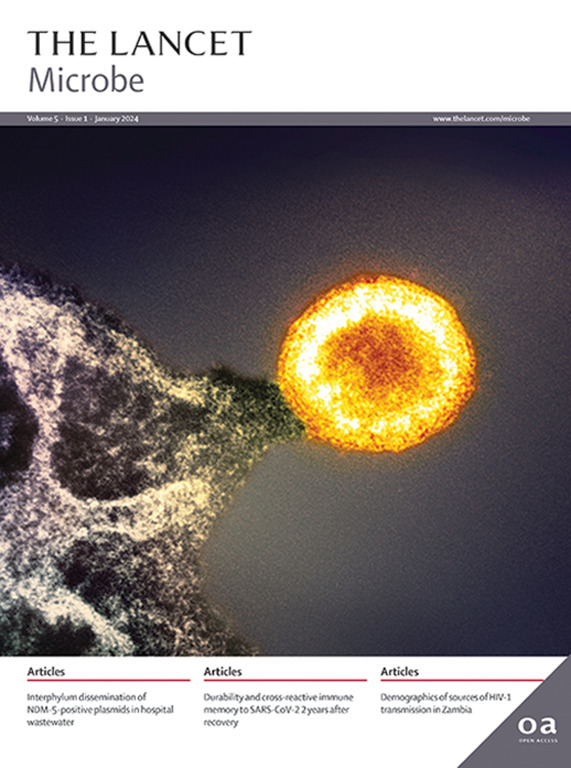Associations of inflammatory markers with post-acute clinical findings among survivors of Ebola virus disease with and without viral RNA shedding in the semen in Liberia: a nested case–control study
IF 20.9
1区 生物学
Q1 INFECTIOUS DISEASES
引用次数: 0
Abstract
Background
A high proportion of survivors of Ebola virus disease (EVD) have post-acute sequelae of EVD (PASE), but the relationship between inflammation and PASE pathogenesis is poorly understood. This study tests the hypothesis that inflammation is associated with PASE among survivors with and without viral RNA shedding in the semen.
Methods
This was a case–control study nested in a longitudinal cohort that recruited confirmed survivors of EVD and their uninfected contacts from the 2013–16 EVD epidemic in Liberia, starting on June 1, 2015. We included participants aged at least 18 years with clinical data and plasma available at cohort baseline for analysis. A semen donation substudy tested male survivors for Ebola virus RNA shedding in the semen. A sex-stratified and survivor-stratified random sample of cases (survivors) and controls (contacts) was obtained to select stored baseline plasma samples for cytokine testing of markers of inflammation, immune regulation, and antiviral responses. Serostatus of cases and controls was confirmed by Filovirus Animal Nonclinical Group assay. We identified inflammatory markers (adjusted p≤0·05) elevated in cases compared with controls and then used these biomarkers in analyses comparing survivors with and without pre-specified PASE-associated clinical findings (self-reported symptoms and abnormal examination findings). Survivors with viral RNA shedding in the semen formed subgroup analyses.
Findings
Our analysis cohort consisted of 1044 participants (594 survivors of EVD and 450 uninfected contacts); 515 (49·3%) were female and 529 (50·7%) were male. The subcohort of 243 male survivors with data on viral shedding included 81 (33%) participants with viral shedding in semen. Median time from acute EVD to baseline was 317 days (IQR 271–366). Survivors of EVD showed a pattern of elevated inflammatory markers indicative of macrophage (MCP-1, IL-1β, and M-CSF) and angiogenic factor activation (VEGF-A) compared with controls (adjusted p<0·05). In survivors with viral shedding in the semen compared with controls, VEGF-A was the only inflammatory marker that was significantly higher (adjusted p<0·001). After restricting the analysis to survivors, each inflammatory marker had a specific pattern of clinical findings. Higher levels of IL-1β were associated with higher odds of urinary frequency (p=0·002), musculoskeletal abnormalities (p=0·003), and abdominal abnormalities (p=0·03). By contrast, higher levels of MCP-1 were associated with lower odds of the same clinical findings. M-CSF was the only inflammatory marker associated with lower odds of joint pain (p=0·04). Higher levels of VEGF-A were associated with higher odds of abnormal chest findings in the overall survivor group (p=0·02) and in the subgroup with viral shedding in the semen (p=0·02).
Interpretation
We found evidence of distinct biological pathways for PASE. Although viral RNA shedding in the semen could be associated with angiogenic activation, it did not explain many of the PASE symptoms and exam findings associated with the elevated macrophage markers, suggesting the pathobiology of some clinical manifestations might be autoimmunity, immune dysregulation, or another biological mechanism. These findings could inform shared biological pathways with other infection-associated chronic conditions, including post-acute sequelae of SARS-CoV-2 infection.
Funding
National Cancer Institute and National Institute of Allergy and Infectious Diseases at the US National Institutes of Health.
利比里亚有和没有病毒RNA在精液中脱落的埃博拉病毒病幸存者中炎症标志物与急性后临床表现的关联:一项巢式病例对照研究
背景:很高比例的埃博拉病毒病(EVD)幸存者有EVD急性后后遗症(PASE),但炎症与PASE发病机制之间的关系尚不清楚。本研究验证了在精液中有或没有病毒RNA脱落的幸存者中炎症与PASE相关的假设。方法:这是一项基于纵向队列的病例对照研究,该研究招募了自2015年6月1日起利比里亚2013- 2016年埃博拉病毒病流行的埃博拉病毒病确诊幸存者及其未感染接触者。我们纳入了年龄在18岁以上且在队列基线时具有临床资料和血浆的受试者进行分析。一项精液捐献亚研究测试了男性幸存者精液中是否有埃博拉病毒RNA脱落。对患者(幸存者)和对照组(接触者)进行性别分层和幸存者分层随机抽样,选择储存的基线血浆样本,用于炎症、免疫调节和抗病毒反应标志物的细胞因子检测。用丝状病毒动物非临床组试验确定病例和对照组的血清状态。我们发现,与对照组相比,病例中的炎症标志物(调整p≤0.05)升高,然后使用这些生物标志物进行分析,比较有和没有预先指定的pase相关临床表现(自我报告的症状和异常检查结果)的幸存者。精液中有病毒RNA脱落的幸存者形成了亚组分析。结果:我们的分析队列包括1044名参与者(594名EVD幸存者和450名未感染的接触者);女性515例(49.3%),男性529例(50.7%)。243名有病毒脱落数据的男性幸存者亚队列包括81名(33%)精液中有病毒脱落的参与者。从急性埃博拉病毒病到基线的中位时间为317天(IQR 271-366)。与对照组相比,EVD幸存者表现出巨噬细胞(MCP-1, IL-1β和M-CSF)和血管生成因子激活(VEGF-A)的炎症标志物升高的模式(调整后)。尽管精液中的病毒RNA脱落可能与血管生成激活有关,但它并不能解释许多与巨噬细胞标志物升高相关的PASE症状和检查结果,提示一些临床表现的病理生物学可能是自身免疫、免疫失调或其他生物学机制。这些发现可以为与其他感染相关的慢性疾病(包括SARS-CoV-2感染的急性后后遗症)共享的生物学途径提供信息。资助:美国国立卫生研究院国家癌症研究所和国家过敏和传染病研究所。
本文章由计算机程序翻译,如有差异,请以英文原文为准。
求助全文
约1分钟内获得全文
求助全文
来源期刊

Lancet Microbe
Multiple-
CiteScore
27.20
自引率
0.80%
发文量
278
审稿时长
6 weeks
期刊介绍:
The Lancet Microbe is a gold open access journal committed to publishing content relevant to clinical microbiologists worldwide, with a focus on studies that advance clinical understanding, challenge the status quo, and advocate change in health policy.
 求助内容:
求助内容: 应助结果提醒方式:
应助结果提醒方式:


